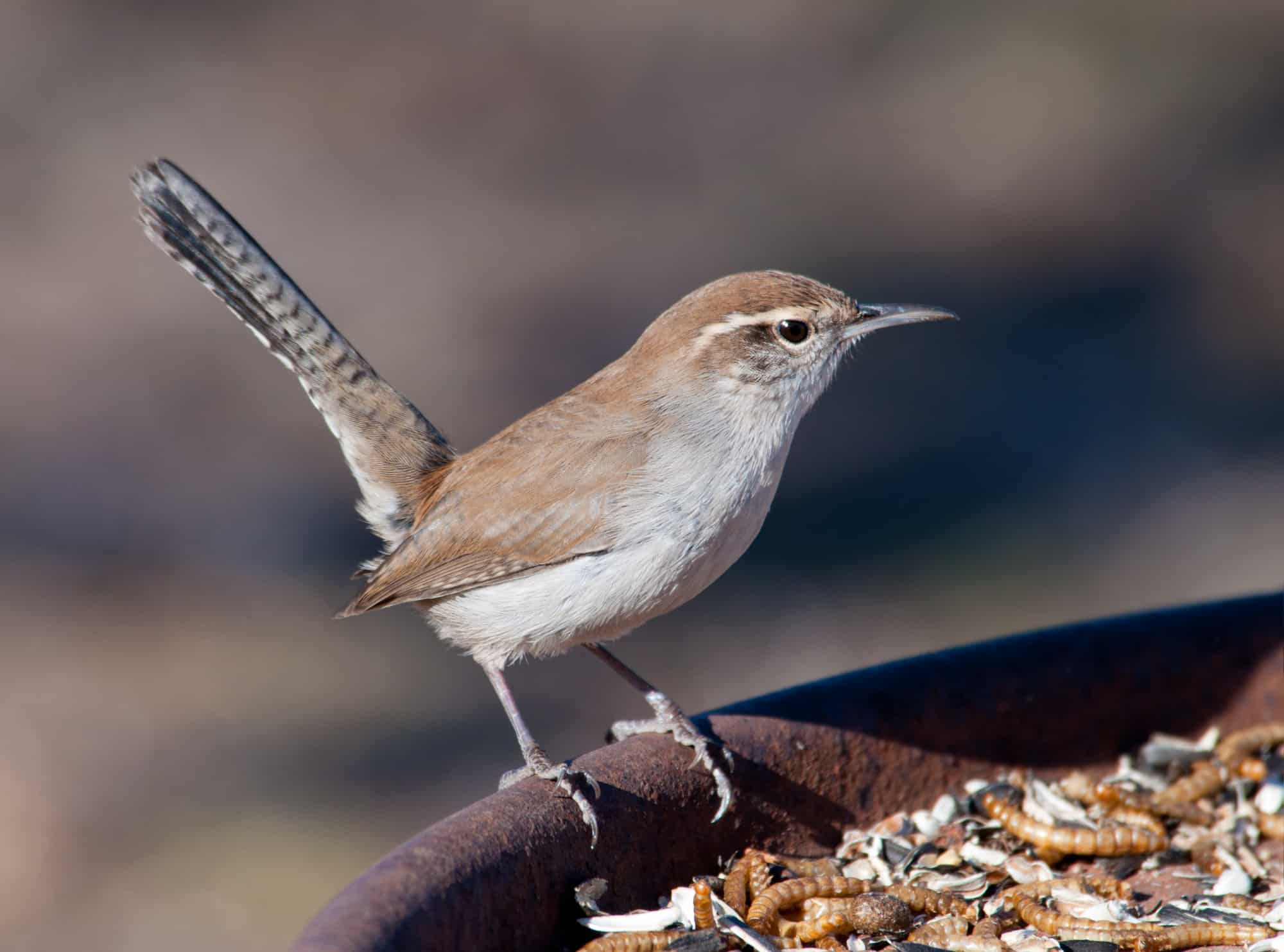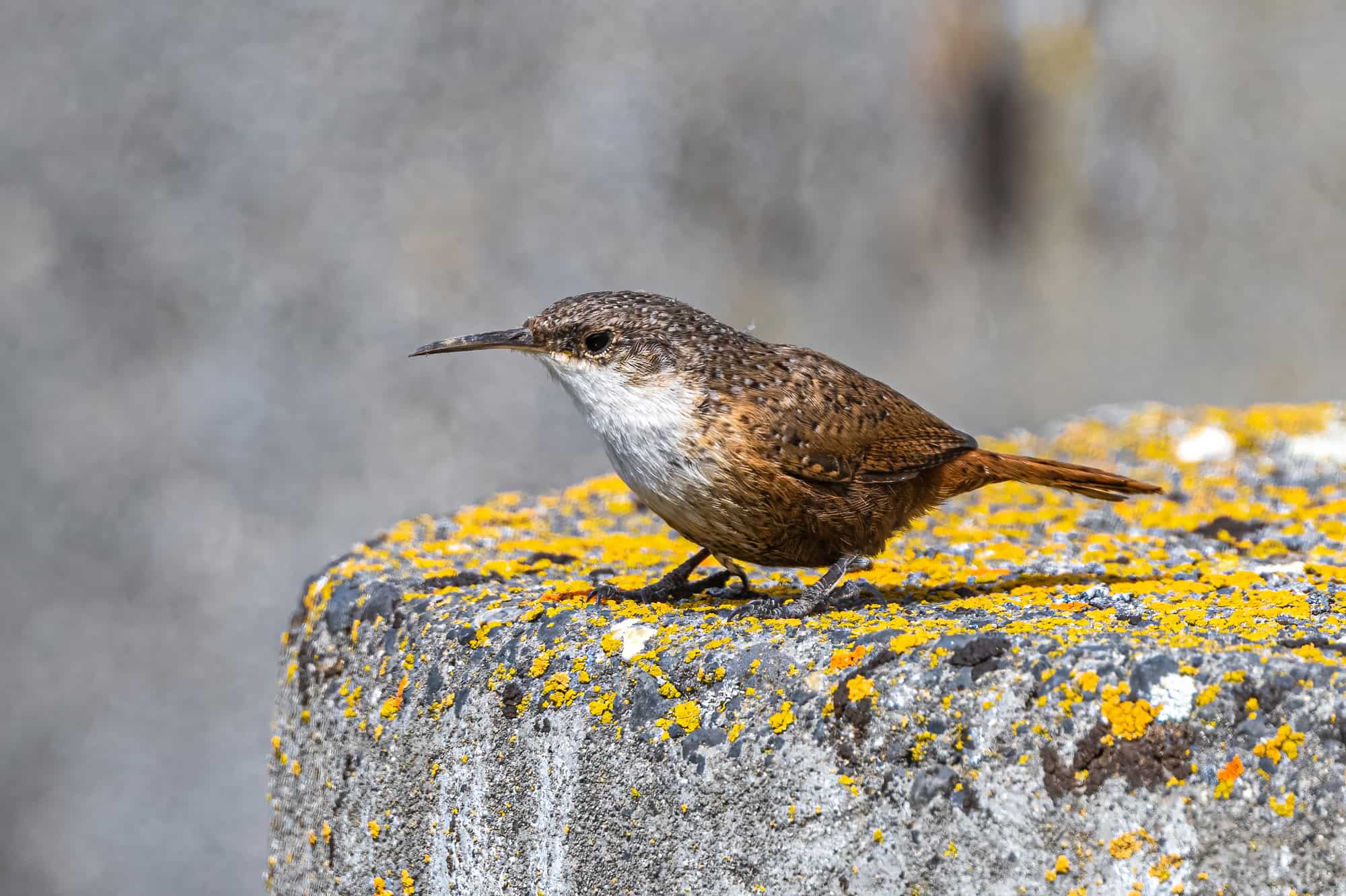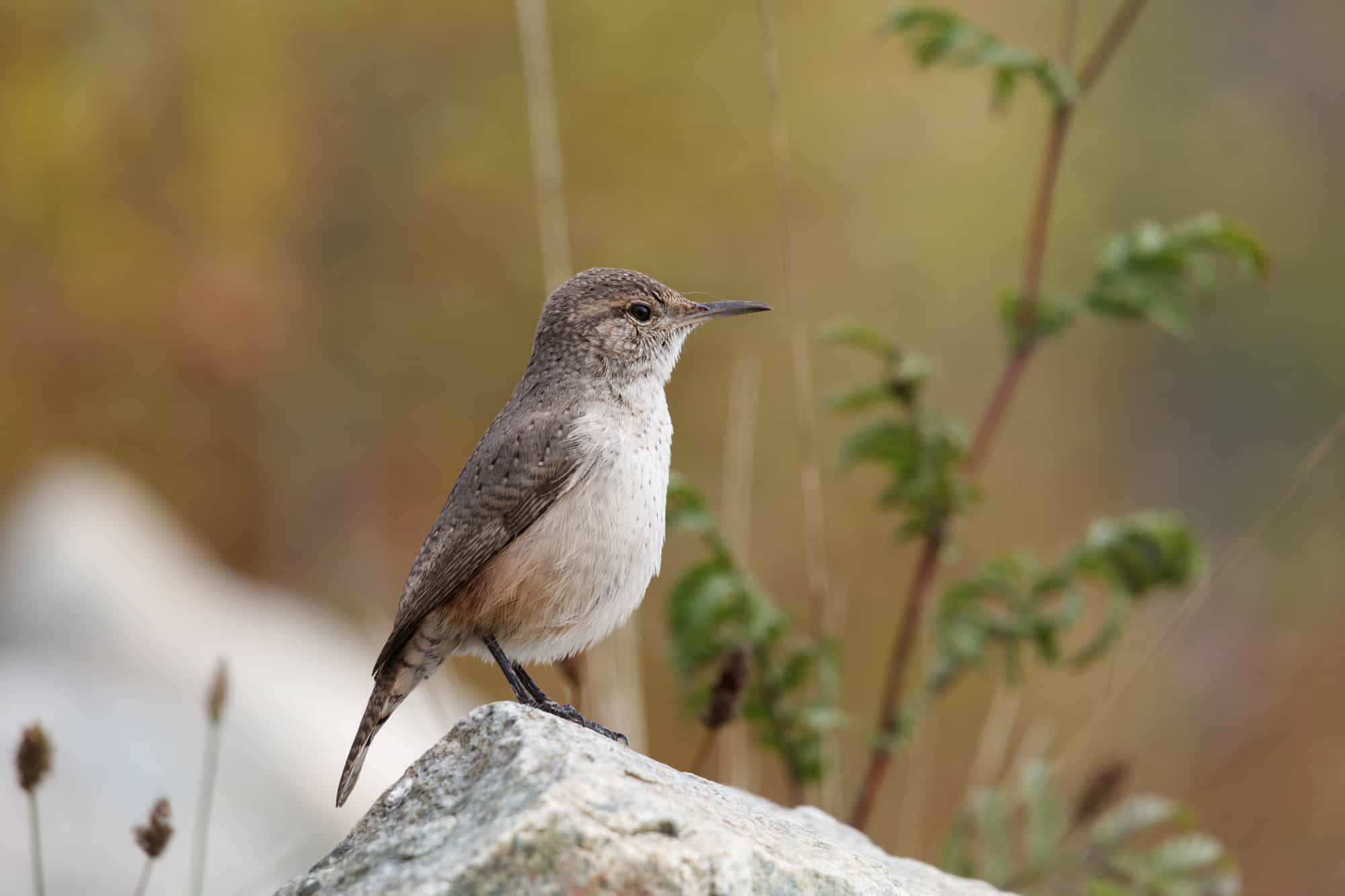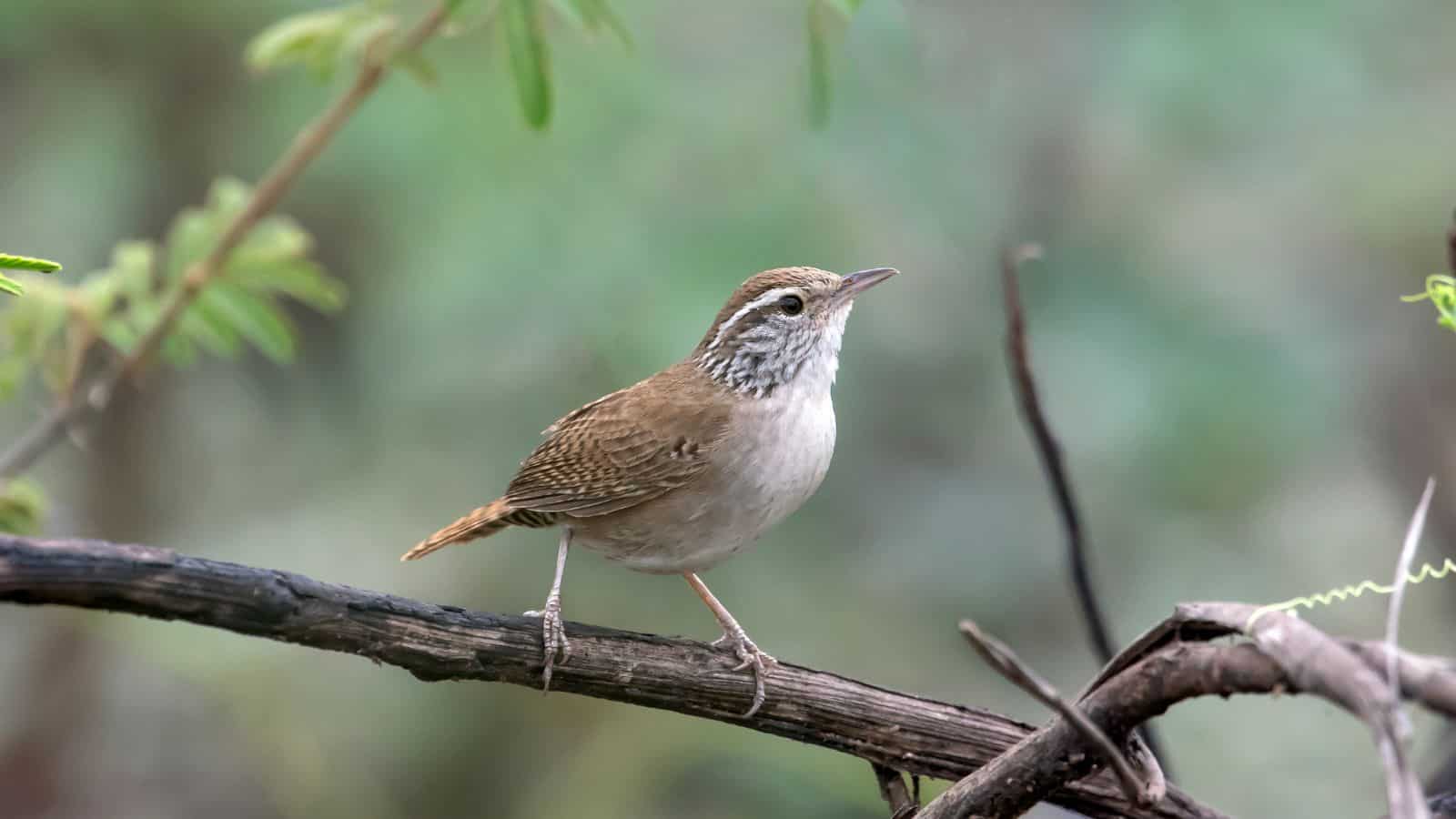There are eleven wren species in North America, but Arizona is the only state to host every one of them! The varied landscapes and mild climate of the Grand Canyon State seem to have something to tempt every member of this diverse family to visit.
However, that’s not to say that all wrens make their permanent homes in Arizona. Rather, several species are very seldom spotted and should be considered more as accidental vagrants than true residents.
Perhaps, like us, wrens just can’t resist visiting the bright, sunny climate and dramatic landscapes that Arizona offers!
Wrens are among the smallest birds in America, but you may be surprised at the variation in the size and shape of this family when you see the species side by side. They often have fabulous voices, and learning each species’ song is a great way to locate and identify them.
Whether you’re a local resident or a touring bird watcher, we hope that this guide helps you get a better understanding of Arizona’s amazing wealth of wrens.
11 Wrens in Arizona, Starting With the Most Common
Cactus Wren

- Scientific Name: Campylorhynchus brunneicapillus
- Length: 7.1-8.7 in (18-22 cm)
- Weight: 1.1-1.7 oz (32-47 g)
- Wingspan: 11 in (28cm)
There are two wren species that are commonly seen year-round in Arizona, and the first is the cactus wren. Similar in size to the spotted towhee, these birds easily take the prize for being the biggest wren variety in North America!
Apart from their large proportions, cactus wrens are easy to recognize by their spotted chest and long, curved beaks. The place to find them is in low cactus and brushy areas in the desert.
The cunning cactus wrens use the spiny desert plants in their habitat to maximum effect during the breeding season. By building football-shaped nests in cholla and saguaro cacti, their nests are protected from potential predators like snakes.
Although they’re common birds in southern and western Arizona, they’re mostly absent from the higher elevations in the northeast of the state where the climate is colder.
Bewick’s Wren

- Scientific Name: Thryomanes bewickii
- Length: 5.1 in (13 cm)
- Weight: 0.3-0.4 oz (8-12 g)
- Wingspan: 7 in (17.8cm)
Appearing at a similar frequency to the cactus wren in Arizona is the much smaller Bewick’s wren. Although they aren’t the smallest wren species, they can sometimes weigh as little as two credit cards!
Bewick’s wren is a pretty little bird, easily recognized by its pale gray belly and long white eyebrows. They can also be identified by their varied buzzing and whistling songs, and will often raise raucous alarm calls when humans or other potential threats come too close for comfort.
Thankfully, the brushy habitats of Arizona provide a stronghold for Bewick’s wren, a bird that has been disappearing at a rapid rate from more easterly states. It’s thought that competition from house wrens is partly to blame for their demise.
Bewick’s wrens can be attracted to backyards by offering them appropriate nest boxes and may also visit feeding platforms and tube feeders in the winter months to eat seeds and dried berries.
House Wren

- Scientific Name: Troglodytes aedon
- Length: 4.3-5.1 in (11-13 cm)
- Weight: 0.3-0.4 oz (10-12 g)
- Wingspan: 5.9 in (15 cm)
House wrens are not only the most widespread wrens in North America, but they’re also the most cosmopolitan bird in all the Americas! Found from Northern Canada to the tip of Patagonia, there’s hardly a province in between where they can’t be found at some time of the year.
In most of Arizona, house wrens are seen exclusively during the breeding season, except in the southern quarter of the state where they usually only appear in winter. They can be recognized by their slender shape, barred wings and tail, and the bubbling trills of their song.
These tiny birds build their nests in almost any cavity they can find, including woodpecker holes, mailboxes, or even old coat pockets!
You can help house wrens find the perfect place to raise their young by offering them a birdhouse in your backyard and leaving some overgrown corners of the garden where they can forage about!
Canyon Wren

- Scientific Name: Catherpes mexicanus
- Length: 4.5-6.1 in (11.4-15.4 cm)
- Weight: 0.3-0.7 oz (9.9-18.3 g)
- Wingspan: 7.1-7.9 in (18-20 cm)
The aptly named canyon wren is an arid climate specialist that is found almost exclusively on sheer cliffs and vertical rock formations, often near water.
Using its incredibly long bill, the canyon wren pokes and probes cracks and cavities in the rock’s face, in search of the insects and spiders that make up the bulk of its diet.
With a clean white throat and a dark rufous underbelly, the canyon wren is a handsome and enchanting little bird.
But apart from its good looks, the canyon wren also has one of the most therapeutic, soothing songs of all wrens. The series of cascading whistles, echoing over the stark, arid landscapes they inhabit are a calming balm for the soul.
Rock Wren

- Scientific Name: Salpinctes obsoletus
- Length: 4.9-5.9 in (12.5-15 cm)
- Weight: 0.5-0.6 oz (15-18 g)
- Wingspan: 8.7-9.4 in (22-24 cm)
Rock wrens are found throughout Western America, but according to Sibley’s Guide to Birds, Arizona is the only state where they can be found year-round throughout. It seems that the dry, rocky landscapes of The Grand Canyon State offer the perfect habitat for these aptly-named birds to thrive.
- Sibley Guide To Birds, 2nd Ed
- Sibley, David Allen (Author)
- English (Publication Language)
Last update on 2024-04-27 / Affiliate links / Images from Amazon Product Advertising API
Rock wrens are the palest species of wren in North America. They have a gray, speckled upper body, a white throat, and a slightly pinkish belly. They’re often seen singing their repetitive songs while standing atop large boulders.
These largish wrens have the remarkable habit of embellishing their nest sites with a paving of rocks and pebbles. The collection can weigh more than 3lb in total and scientists have concluded that it provides multiple benefits, including flood protection and predator detection.
Like canyon wrens, rock wrens use their long bill to search out and scoop up invertebrates that live in the rocky crevices of their natural habitats.
Marsh Wren

- Scientific Name: Cistothorus palustris
- Length: 3.9-5.5 in (10-14 cm)
- Weight: 0.3-0.5 oz (9-14 g)
- Wingspan: 5.9 in (15 cm)
Marsh wrens are one of the few wrens that are much more common in Arizona during the winter than in summer. Although a small territory in the southwest of the state hosts these tiny birds throughout the year, they’re otherwise regarded as winter visitors.
Despite being a largely migratory species, marsh wrens are among the most territorial members of the wren family. With great aggression and fervor, they defend their marshland habitats with their booming voice and even by chasing away larger birds.
It’s their loud, raucous song that’s the easiest way to locate marsh wrens who are otherwise secretive, well-camouflaged birds. Since they’re rarely seen anywhere except in standing water, you might need a good pair of binoculars to observe them from afar.
Pacific Wren

- Scientific Name: Troglodytes pacificus
- Length: 3.1-4.7 in (8-12 cm)
- Weight: 0.3-0.4 oz (8-12 g)
- Wingspan: 4.7-6.3 in (12-16 cm)
Pacific wrens and winter wrens are so similar that, until recently, they were thought to be the same species. Since they’ve both been recorded in Arizona, it can be difficult to decipher sightings and make out which species is more common here.
According to Arizona field ornithologists, the Pacific wrens are considered to be the most frequent visitor in the state, and the Sibley Bird Guide indicates a breeding population in the center of the state.
Nevertheless, Pacific wrens are incredibly rare in Arizona and have only been recorded in around one in a thousand bird watcher reports. These tiniest of birds are secretive and well-camouflaged, making spotting them even more difficult than other species.
The real giveaway that a Pacific wren is in the vicinity is their complex, high-pitched song that they belt out with breathtaking gusto. Their trills are noted to be a little faster than their eastern cousins.
Winter Wren

- Scientific Name: Troglodytes hiemalis
- Length: 3.1-4.7 in (8-12 cm)
- Weight: 0.3-0.4 oz (8-12 g)
- Wingspan: 4.7-6.3 in (12-16 cm)
The eastern cousin of the Pacific wren, is, of course, the winter wren. Although they’re rarely seen further east than Eastern Texas, they are very occasionally spotted in Arizona.
Along with the Pacific wren, the winter wren claims the prize for being the smallest wren in America. Although both species are fairly plump birds, they sometimes only measure 3 inches from tip to tail!
Damp woodlands are the favorite haunt of the winter wren – a habitat niche that’s noticeably lacking in Arizona. It’s probably safe to consider the species an accidental visitor rather than a true resident of the Grand Canyon State.
Sinaloa Wren

- Scientific Name: Thryophilus sinaloa
- Length: 4.6 -5.5 in (12-14 cm)
- Weight: 0.38 -0.70 oz (11-20 g)
- Wingspan: 7in (18cm)
Now, for the rarest wren in the entire USA! The Sinaloa wren is found only in Southern Arizona and no other state in America. The species is a native bird in Mexico and is only considered an occasional visitor in the States.
With some resemblance to Bewick’s wren, the Sinaloa wren is noticeably plumper, with a darker, rusty-red color, and a spotted breast. Its rapid, warbling song has an almost tropical lilt to it, clueing us to this bird’s true home.
Sinaloa wrens should always be considered a prized sighting north of the border. If you see one in Arizona, try to get a photo of it and submit it to a local birdwatching authority such as the Arizona field ornithologists.
Carolina Wren

- Scientific Name: Thryothorus ludovicianus
- Length: 4.7-5.5 in (12-14 cm)
- Weight: 0.6-0.8 oz (18-22 g)
- Wingspan: 9 in (23 cm)
Carolina wrens might be the most commonly seen wren in North America, but they’re mostly confined to The East and are rarely seen further west than Oklahoma and Eastern Texas.
The reports of Carolina wrens in Arizona, must, therefore, be considered accidental. Perhaps particularly adventurous individuals were simply exploring Western frontiers.
Carolina wrens are pretty birds with white throats, long white eyebrows, and a pinkish belly. With a wingspan of around 9 inches, they’re also one of the largest wrens in North America.
These relatively bold wrens prefer to frequent overgrown woodlands and brushy areas, but can also be seen in backyards. They regularly visit birdhouses and bird feeders in the eastern states.
Sedge Wren

- Scientific Name: Cistothorus stellaris
- Length: 3.9-4.7 in (10-12 cm)
- Weight: 0.3oz (7-10 g)
- Wingspan: 4.7-5.5 in (12-14 cm)
The last of our super-rare wrens in Arizona is the sedge wren. More of a bird of the Eastern States, the sedge wren will occasionally stray into New Mexico, but hardly ever as far west as Arizona.
All the same, sedge wrens have been reported here, meaning we can safely say that all eleven of America’s wrens have been seen in Arizona.
Like marsh wrens, sedge wrens enjoy damp habitats but are generally less wet than their cousins. Whereas marsh wrens need standing water to feel at home, sedge wrens will happily adopt a damp meadow for their home.
These shy, well-camouflaged birds are very difficult to spot, making your chances of spotting one in Arizona even slimmer! Their presence is usually revealed by their sharp, rapid chatter.
Conclusion
Something of a wren hotspot, Arizona is the only state in America to boast all eleven of North America’s wrens.
From the regularly seen cactus wren in the state’s deserts to the elusive Sinaloa Wren that occasionally creeps over the border from Mexico, there are endless opportunities to encounter these enchanting birds in The Grand Canyon State.
Whether you’re a local resident or planning a birdwatching trip in The Southwest, don’t miss our guide to the most iconic birds of Arizona here.

